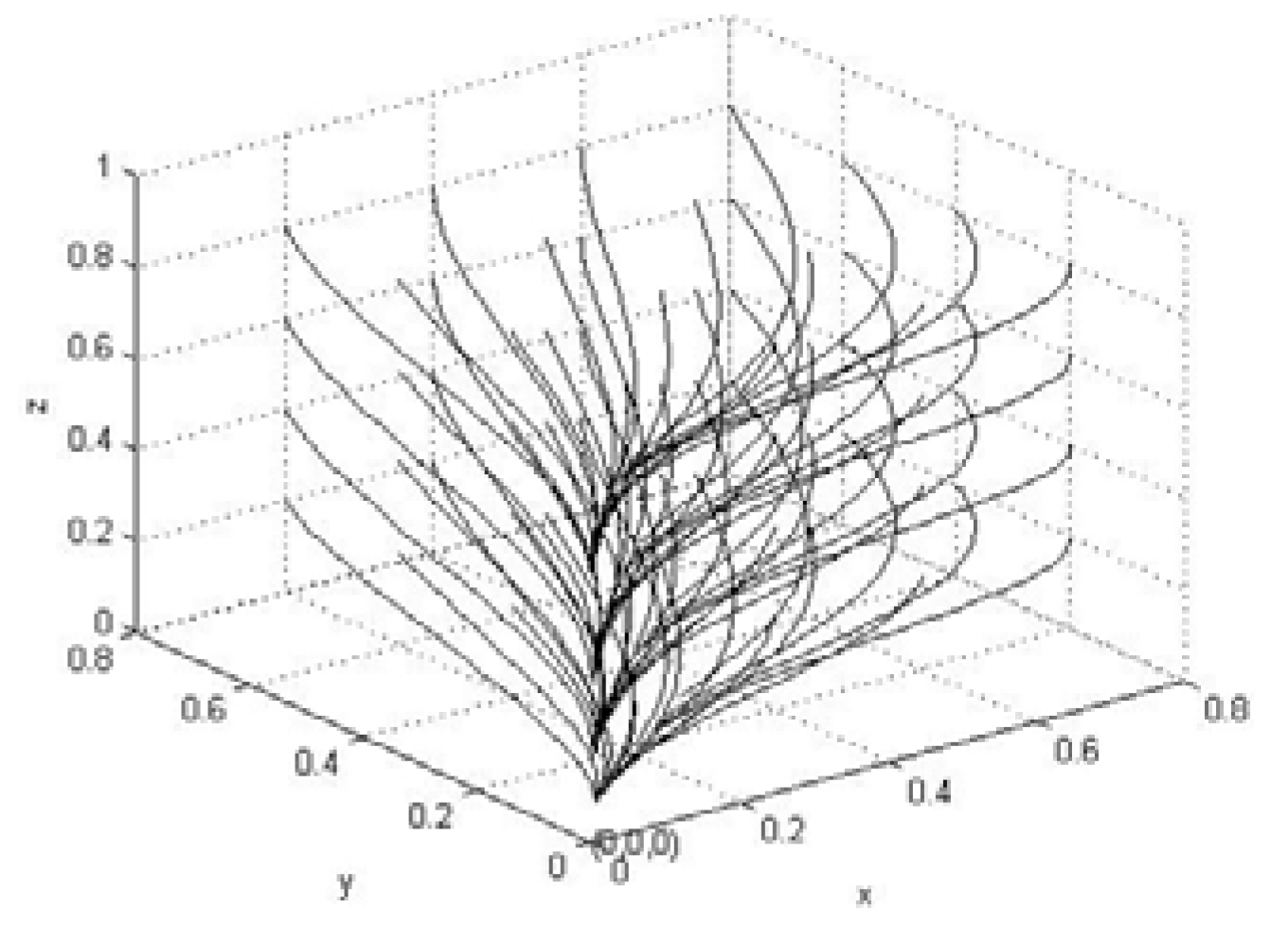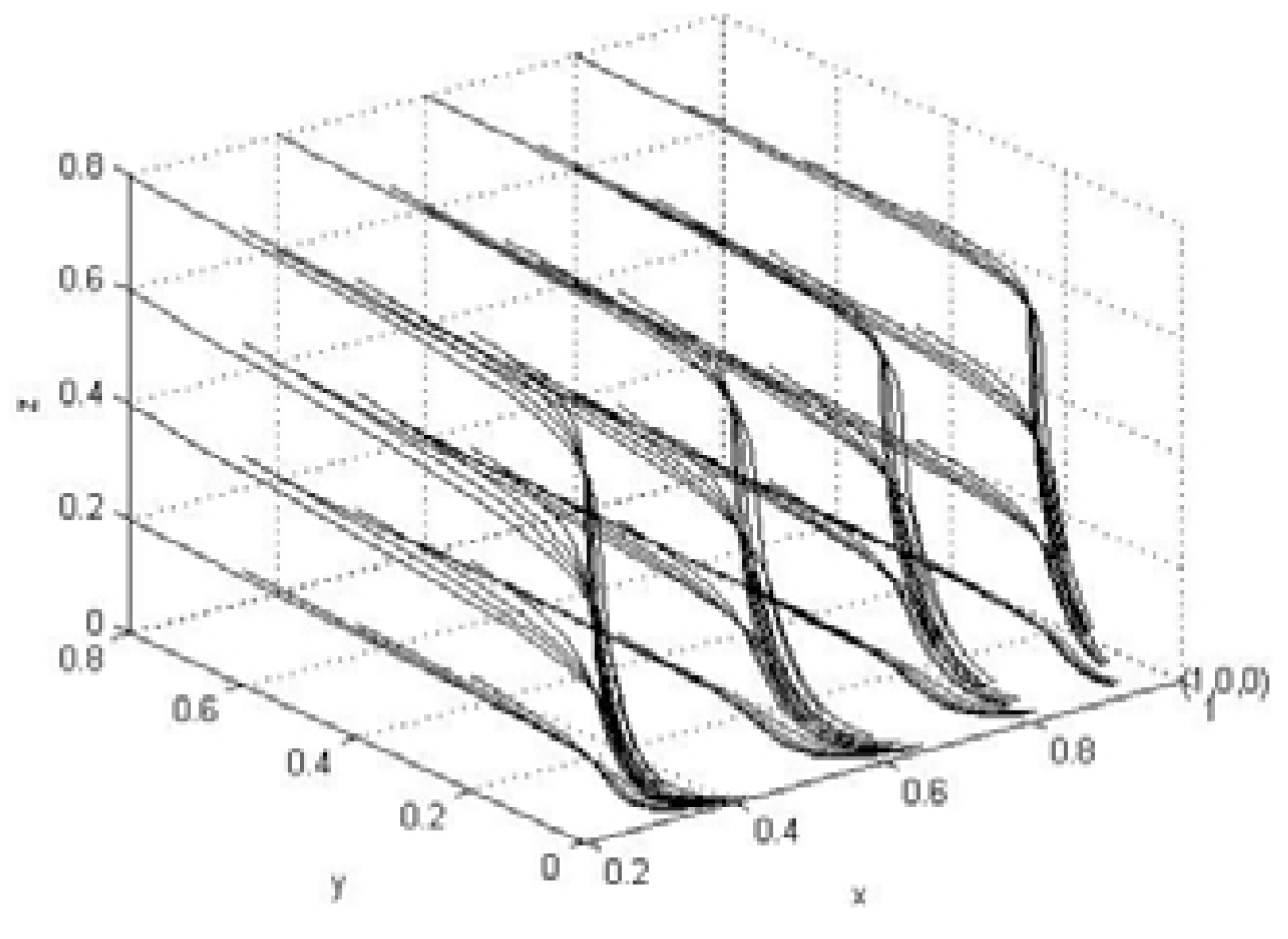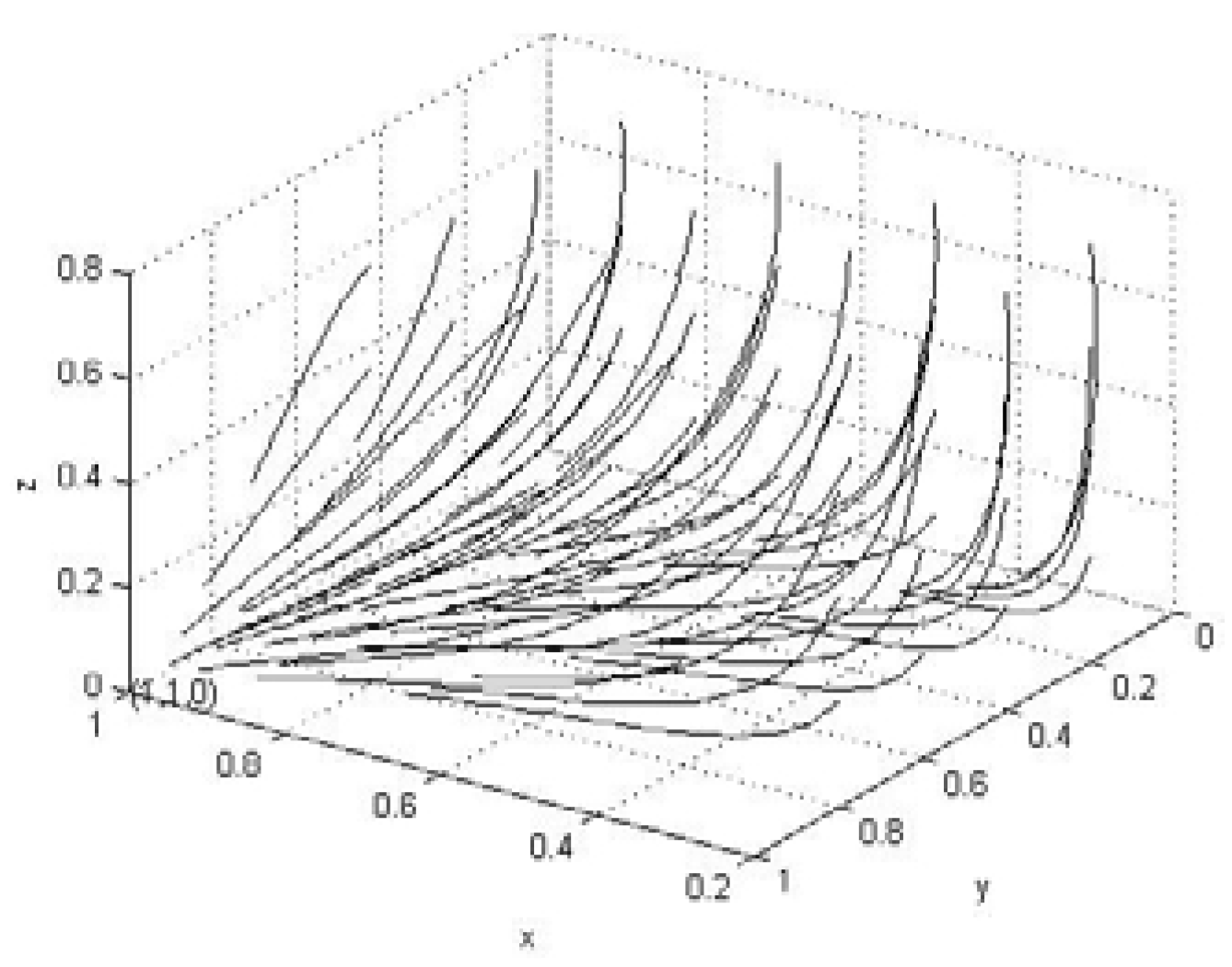Strategy Analysis of Multi-Agent Governance on the E-Commerce Platform
Abstract
:1. Introduction
2. Literature Review
2.1. Multi-Agent Governance and the Role of Participating Agents
2.1.1. The Proposal of Multi-Agent Governance Model
2.1.2. The Role of Government in the Multi-Agent Governance Model
2.1.3. The Role of Internet Platforms in the Multi-Agent Governance Model
2.1.4. The Role of the Public in the Multi-Agent Governance Model
2.2. Application of Multi-Agent Governance in E-Commerce Platform
3. Situation Characterization and Model Hypothesis
4. Game Analysis in the Case of Binary Strategy Sets
4.1. Game Model Construction and Solution
4.2. Product Quality Analysis in Different Stable States
4.2.1. Product Quality Analysis in (0,0,0) State
4.2.2. Product Quality Analysis in (1,0,0) State
4.2.3. Product Quality Analysis in (1,1,0) State
5. Game Analysis in the Continuous Strategy Set Case
5.1. Model Construction and Stability Strategy Analysis
5.2. Product Quality Analysis under Continuous Strategy
6. Conclusions and Limitations
Author Contributions
Funding
Institutional Review Board Statement
Informed Consent Statement
Data Availability Statement
Conflicts of Interest
References
- Deng, Z. Government Officials Social Influencer Marketing: The Mechanism Challenge and Countermeasures of Government Livestreaming + Agriculture. Chin. Public Adm. 2020, 10, 80–85. (In Chinese) [Google Scholar]
- Liu, Y.; Li, N. Legal regulation on false publicity of live streaming e-commerce. Intellect. Prop. 2021, 5, 68–82. (In Chinese) [Google Scholar]
- Ding, G.; Jiang, M. Legal Regulation of the False Promotion in Livestreaming Marketing in China—Comment on the Provisions on the Prohibition of Unfair Competition Online (Draft for Public Comments). China Bus. Mark. 2022, 36, 29–39. (In Chinese) [Google Scholar]
- Bauer, J.M. Platforms, systems competition, and innovation: Reassessing the foundations of communications policy. Telecommun. Policy 2014, 38, 662–673. [Google Scholar] [CrossRef]
- Bunge, M. Systemism: The alternative to individualism and holism. J. Socio-Econ. 2000, 29, 147–157. [Google Scholar] [CrossRef]
- Zajko, M. Telecom responsibilization: Internet governance, surveillance, and new roles for intermediaries. Can. J. Commun. 2016, 41, 75. [Google Scholar] [CrossRef] [Green Version]
- Stier, S.; Schünemann, W.J.; Steiger, S. Of activists and gatekeepers: Temporal and structural properties of policy networks on Twitter. New Media Soc. 2018, 20, 1910–1930. [Google Scholar] [CrossRef]
- Suzor, N.; Van Geelen, T.; Myers West, S. Evaluating the legitimacy of platform governance: A review of research and a shared research agenda. Int. Commun. Gaz. 2018, 80, 385–400. [Google Scholar] [CrossRef] [Green Version]
- Gorwa, R. What is platform governance? Information. Commun. Soc. 2019, 22, 854–871. [Google Scholar]
- Southwell, B.G.; Thorson, E.A. The Prevalence, Consequence, and Remedy of Misinformation in Mass Media Systems. J. Commun. 2015, 4, 4. [Google Scholar] [CrossRef]
- Janssen, M.; Estevez, E. Lean government and platform-based governance—Doing more with less. Gov. Inf. Q. 2013, 30, S1–S8. [Google Scholar] [CrossRef]
- Hagiu, A.; Wright, J. Multi-sided platforms. Int. J. Ind. Organ. 2015, 43, 162–174. [Google Scholar] [CrossRef]
- Fenwick, M.; McCahery, J.A.; Vermeulen, E.P.M. The end of ‘corporate’ governance: Hello ‘platform’ governance. Eur. Bus. Organ. Law Rev. 2019, 20, 171–199. [Google Scholar] [CrossRef] [Green Version]
- De Nardis, L.; Hackl, A.M. Internet governance by social media platforms. Telecommun. Policy 2015, 39, 761–770. [Google Scholar] [CrossRef]
- Gillespie, T. The politics of ‘platforms’. New Media Soc. 2010, 12, 347–364. [Google Scholar] [CrossRef]
- Lin, T.C.; Cheng, H.K.; Wang, F.-S.; Chang, K.-J. A study of online auction sellers’ intention to switch platform: The case of Yahoo! Kimo versus Ruten_eBay. Decis. Sci. 2012, 43, 241–272. [Google Scholar] [CrossRef]
- Grewal, R.; Chakravarty, A.; Saini, A. Governance mechanisms in business-to-business electronic markets. J. Mark. 2010, 74, 45–62. [Google Scholar] [CrossRef]
- Plambeck, E.L.; Taylor, T.A. Supplier evasion of a buyer’s audit: Implications for motivating supplier social and environmental responsibility. Manuf. Serv. Oper. Manag. 2016, 18, 184–197. [Google Scholar] [CrossRef] [Green Version]
- Krämer, J.; Schnurr, D. Is there a need for platform neutrality regulation in the EU? Telecommun. Policy 2018, 42, 514–529. [Google Scholar] [CrossRef]
- Burguet, R.; Caminal, R.; Ellman, M. In Google we trust? Int. J. Ind. Organ. 2015, 39, 44–55. [Google Scholar] [CrossRef] [Green Version]
- Ursu, R.M. The power of rankings: Quantifying the effect of rankings on online consumer search and purchase decisions. Mark. Sci. 2018, 37, 530–552. [Google Scholar] [CrossRef] [Green Version]
- Rowe, G.; Frewer, L.J. A typology of public engagement mechanisms. Sci. Technol. Hum. Values 2005, 30, 251–290. [Google Scholar] [CrossRef]
- Janssen, M.; Helbig, N. Innovating and changing the policy-cycle: Policy-makers be prepared! Gov. Inf. Q. 2018, 35, S99–S105. [Google Scholar] [CrossRef]
- Ojo, A.; Mellouli, S. Deploying governance networks for societal challenges. Gov. Inf. Q. 2018, 35, S106–S112. [Google Scholar] [CrossRef]
- Bertot, J.C.; Jaeger, P.T.; Munson, S.; Glaisyer, T. Social media technology and government transparency. Computer 2010, 43, 53–59. [Google Scholar] [CrossRef]
- Mattson, G.A. The promise of citizen coproduction: Some persistent issues. Public Product. Rev. 1986, 10, 51–56. [Google Scholar] [CrossRef]
- Janssen, M.; Charalabidis, Y.; Zuiderwijk, A. Benefits, adoption barriers and myths of open data and open government. Inf. Syst. Manag. 2012, 29, 258–268. [Google Scholar] [CrossRef]
- Song, L.; Huang, Y. “Changes” and “Ordinaries”—Proposal and Countermeasure of E-commerce Live Broadcasting Supervision. Henan Soc. Sci. 2020, 28, 106–114. (In Chinese) [Google Scholar]
- Zhou, D.; Xu, H. Research on E-commerce regulatory Model based on ecosystem. Soc. Sci. Res. 2021, 01, 83–91. (In Chinese) [Google Scholar]
- Wang, X.; Lin, M. The Governance Mechanisms Construction of “Roll-over” Events in Live Streaming E-commerce. Econ. Adm. 2022, 44, 178–191. (In Chinese) [Google Scholar]
- Zhou, J. Difficulties and Countermeasure Innovations of Supervision on E-commerce Live Streaming. China Bus. Mark. 2021, 35, 72–80. (In Chinese) [Google Scholar]
- Lan, J.; Wu, J. On the Theory of Collaborative Regulation in the Era of E-commerce. Chin. Public Adm. 2021, 6, 37–43. (In Chinese) [Google Scholar]
- Mei, A.; Hou, Z. Standardized governance of e-commerce live broadcasting in the era of “live +”. E-Gov. 2021, 3, 28–37. (In Chinese) [Google Scholar]
- Zhou, S. The legal responsibility of the live streaming platform of network broadcast. Appl. Law 2022, 2, 133–144. (In Chinese) [Google Scholar]
- Li, J.; Zhang, R.; Xu, Y. Evolutionary game between E-commerce platform supervision and merchants selling fakes. J. Syst. Eng. 2018, 33, 649–661. (In Chinese) [Google Scholar]
- Miao, Y.; Gong, B.; Cheng, Y. Research on Quality Assurance Strategy of E-commerce Platform Considering Bilateral Effort. Chin. J. Manag. Sci. 2018, 26, 163–169. (in Chinese). [Google Scholar]
- Ma, S.; Fang, C. Punishment Mechanism or Reputation Mechanism: Research on Governing Online Shops Selling Fakes. J. Macro-Qual. Res. 2019, 7, 87–95. (in Chinese). [Google Scholar]
- Zhang, L.; Wang, X.; Li, J. Dynamic Evolutionary Game of Credit Mechanism among Core Populations in E-commerce Ecosystem. Oper. Res. Manag. Sci. 2020, 29, 93–101. (In Chinese) [Google Scholar]
- Wang, D.; Zheng, K. Game and simulation of multi-party behavior of e-commerce product quality supervision—Based on consumer feedback. Manag. Mod. 2022, 42, 140–147. (In Chinese) [Google Scholar]
- Zhu, L.; He, H.; Xu, Y. The Strategy for Supervision with Consumer Participation of Online Shopping Product Quality from the Perspective of Collaboration. J. Macro-Qual. Res. 2022, 10, 86–99. (In Chinese) [Google Scholar]
- Li, C.; Cao, Y.; Wang, C.; Hao, L. Evolutionary Game Simulation of Tripartite Strategy in E-commerce Live Streaming Under Platform Regulation. Complex Syst. Complex. Sci. 2022, 19, 34–44. (In Chinese) [Google Scholar]
- He, Y.; Xie, F. Stochastic Evolutionary Game Analysis on the Industry-University-Institute Collaboration Innovation. Manag. Rev. 2020, 32, 150–162. (In Chinese) [Google Scholar]



| Government, Platform, Merchant | Compliance | Violation | |
|---|---|---|---|
| Regulation | Responsible | neq − (a − 2f)/2M | eq − (a − 2f)/2M |
| k(ne)2 − b/2mf | ke2 − b/2mf − (1 − n)eh | ||
| dne(1 + n2)/4 − dn2/2 | d(e − n2)/2 − (1 − n)eσ | ||
| Irresponsible | neq − a/2M | eq − a/2M | |
| k(ne)2 | ke2 − (1 − n)e(h + σ) | ||
| dne(1 + n2)/4 − dn2/2 | d(e − n2)/2 − (1 − n)eσ | ||
| Deregulation | Responsible | neq | eq − (1 − n)el |
| k(ne)2 − b/2mf | ke2 − b/2mf − (1 − n)eh | ||
| dne(1 + n2)/4 − dn2/2 | d(e − n2)/2 | ||
| Irresponsible | neq | eq − (1 − n)el | |
| k(ne)2 | ke2 − (1 − n)eh | ||
| dne(1 + n2)/4 − dn2/2 | d(e − n2)/2 | ||
| Equilibrium Point | Parameter Conditions | ||
|---|---|---|---|
| (0,0,0) | a > 2Mel(1 − n) | – | – |
| (1,0,0) | a < 2Mel(1 − n) | b > 2mfeσ(1 − n) | d > 4σ(1 − n)/(2 − n3 − n) |
| (1,1,0) | a < 2f + 2Mel(1 − n) | b < 2mfeσ(1 − n) | d > 4σ(1 − n)/(2 − n3 − n) |
Disclaimer/Publisher’s Note: The statements, opinions and data contained in all publications are solely those of the individual author(s) and contributor(s) and not of MDPI and/or the editor(s). MDPI and/or the editor(s) disclaim responsibility for any injury to people or property resulting from any ideas, methods, instructions or products referred to in the content. |
© 2022 by the authors. Licensee MDPI, Basel, Switzerland. This article is an open access article distributed under the terms and conditions of the Creative Commons Attribution (CC BY) license (https://creativecommons.org/licenses/by/4.0/).
Share and Cite
He, H.; Zhang, B. Strategy Analysis of Multi-Agent Governance on the E-Commerce Platform. J. Theor. Appl. Electron. Commer. Res. 2023, 18, 1-18. https://doi.org/10.3390/jtaer18010001
He H, Zhang B. Strategy Analysis of Multi-Agent Governance on the E-Commerce Platform. Journal of Theoretical and Applied Electronic Commerce Research. 2023; 18(1):1-18. https://doi.org/10.3390/jtaer18010001
Chicago/Turabian StyleHe, Hongyang, and Bin Zhang. 2023. "Strategy Analysis of Multi-Agent Governance on the E-Commerce Platform" Journal of Theoretical and Applied Electronic Commerce Research 18, no. 1: 1-18. https://doi.org/10.3390/jtaer18010001




